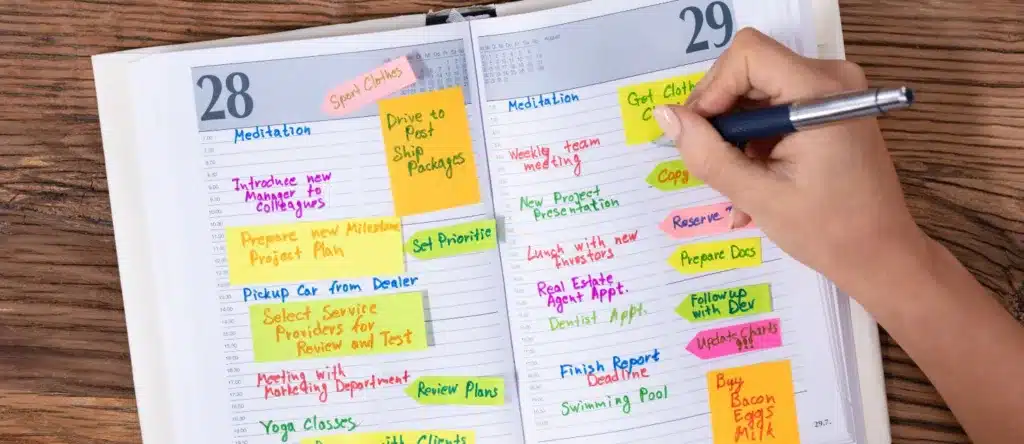When asked about the secret to search ranking success, over 50% of marketing teams said the most important factors were “creating more content,” “posting more often” and “improving the quality.” Do you want more online customers, local leads, and sales? If so, you need to post high-quality content regularly. A content calendar template can help.
What Is a Content Calendar Template?
Content calendars are tracking tools that outline your plans for upcoming content. You can coordinate social media posts, blog articles, and more. These tools are like having a day planner, personal organizer, monthly calendar, and project management platform all in one.
Download Your Free Template
Hands-on learning is a great way to pick up new techniques. With our easy-to-use content calendar template, organizing online marketing is a breeze. Download this free template on any device and see how simple it makes your planning process.
You can also download free to use templates for social media planning and content planning and management across the web such as:
Get Content Calendar Ideas
Use an editorial calendar to supercharge your digital media output.
Brainstorm
Write down content ideas on your calendar whenever they pop into your head, from blog topics to advertising concepts. That way, you don’t forget them.
Include Plenty of Space
Make sure every day on your planner has several slots. Use the same calendar to coordinate blog articles, social media posts, YouTube videos, landing pages, and other items.
Upload and Collaborate
By uploading a content calendar template to the cloud, you can make planning a group effort. Allow team members to make notes or suggestions and keep admin access for yourself.
Ask Your Customers
If you’re running low on fresh ideas, turn to your customers. Client feedback and FAQs can generate content ideas that your audience finds exceptionally useful.
Why Do You Need a Content Calendar?
Creating your own content is an excellent goal, but it’s not easy to achieve. As a business owner, you have a busy schedule. Phone calls and meetings can distract you.
Has your posting frequency fallen behind? Using a content calendar to plan can be an ideal solution. Many tools allow you to set reminders or even upload content automatically.

How Can You Design a Custom Content Calendar for Your Business?
Learn how to create a content calendar from scratch in just six simple steps.
Step 1: Decide Which Details to Include
Customize your content planner for the needs of your business. Some managers prefer simple layouts, and others include a variety of details. Good options include:
- Type of content: Blog article, social media post, web page, new product, video, etc.
- Topic: The overall focus of the content or the title
- Target publish date: When you want to upload the content
- Platform: Your website, Facebook or Instagram accounts, YouTube, Amazon page, etc.
- Keywords: Search terms to support your SEO efforts
- Completed text, image, or video files: Links to the location of content you’re uploading
If you manage multiple marketing professionals, you should also include space for task assignments. That way, the entire team knows who is responsible for what and when.
Step 2: Select a Format
Next, choose the platform you want to use for your calendar. Free options are popular while paid tools often have extra features. Check out a few possibilities:
- Microsoft Excel Spreadsheets: Simple and effective, Excel spreadsheets are easy to customize. You can add as many columns for details as you want.
- Google Sheets: Ideal for collaboration, Google Sheets are available (and free!) to anyone who has a Google account. The only downside is that this do-it-yourself option is mainly for organization. You have to upload the content yourself.
- WordPress Editorial Calendar: A great free calendar for websites that use WordPress, this plugin sadly doesn’t support online collaboration. For solo work, it offers many bells and whistles.
- Meta Business Suite: Your dashboard shows your upcoming posts, and you can schedule them to be published automatically. This option is only valuable for Facebook and Instagram posts.
If you’re looking for enterprise-level tools, you can also find paid options that keep everything at your fingertips. SproutSocial, Jotform, and Notion have flexible tools with tabs that can show you a quick overview or extensive details for each piece.
Step 3: Choose Your Topics
Make a list of topics you want to cover with your content. This requires research. Focus on topics that will interest and help your target audience. Think about titles that align with your company’s goals, too, such as getting more leads or promoting new products.
Step 4: Create Your Content
At Digital Neighbor, we add a special ingredient to the content creation process: SEO. In addition to designing engaging blogs and social media posts, we also perform keyword research. Keywords improve your search rankings, help your content reach the right audience, and drive traffic to your website.
Step 5: Publish
Either upload your posts by hand or schedule them to post automatically on a certain date and time. If you choose DIY, learn the steps for each platform in advance. Videos are notorious for long upload times.
Step 6: Track Performance and Adjust
Keep tabs on how your posts are performing. This data can help you make tweaks to your upcoming topics and formats.

What Are the Benefits of Using a Content Calendar?
There are virtually no downsides to these tools.
Better Results
According to a 2023 survey of the top-performing content marketing companies:
- Over 60% use a document content marketing strategy (which means content calendars).
- Over 75% use collaboration tools for content creation (also content calendars).
- Around 80% track content performance (you guessed it).
Teamwork and Efficiency
Having your content plans clearly outlined allows marketing teams to work together effectively and efficiently. You minimize mistakes, confusion, and wasted resources.
Control Over Content Strategy
A content calendar template makes your marketing more flexible. You can time posts so they coincide with important events, seasonal trends, local collaborations, or special marketing campaigns.
Consistency
Remembering to post regularly is essential for brand engagement and customer relationships. It keeps people interested in your products and grows your online community.
Maximum Content Value
Last-minute content tends to be lower in quality than pieces you carefully plan in advance. Put simply, using a content calendar gives you more bang for your buck.
FAQs
Our team can answer any of your questions regarding content creation and social media. Here are the top questions business owners ask us.
How Many Blogs Should We Post Each Month?
The specifics depend on your target audience, SEO goals, and current number of blogs. We recommend at least four to eight high-quality articles a month.
How Far in Advance Should We Plan Content?
Plan at least a few months in advance. Some businesses schedule up to six months on their content calendars, but this can reduce your flexibility.
How Often Do We Need to Post on Social Media?
To maximize engagement, plan on posting at least one or two times every day to most social media accounts. For B2B clients, post at least three times a week on LinkedIn.
How Can Our Team Help with Content Marketing?
At Digital Neighbor, we provide complete content marketing services. We can handle as much or as little as your business needs, all the way from planning to publishing. Use our helpful content calendar template to manage social media in-house or have our team take care of everything for you.



